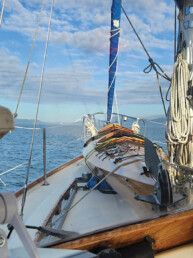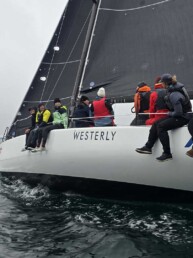THE DYNAMIC, FRAGILE GEM OF SOUTHEAST ALASKA
From the APRIL issue of 48° North.
Glacier Bay: The utterance of those syllables alone causes anyone who has cruised these majestic waters to glaze-over in a faraway gaze. Almost instantly, they’re transported back to the profound inspiration and wonder of this one-of-a-kind wilderness, reflecting on the respect for the natural environment it instills. It certainly does for me. In 48° North’s “Alaska Issue” last June, I called out Glacier Bay National Park & Preserve as being a must-see destination in Southeast Alaska. It truly is, but it’s more than just another great cruising area to circle on your chart.
Enshrined as a National Monument 34 years before Alaska became a state, and named a UNESCO World Heritage Site in 1979 and a UNESCO Biosphere Reserve in 1986, Glacier Bay is internationally recognized as a world treasure. The collaboration between National Park and Biosphere Preserve programs has protected more than three-million acres of wilderness, all while abiding by the Biosphere Preserve program’s mission to “ensure environmental, economic, and social (including cultural and spiritual) sustainability.” Glacier Bay is treated by these managing entities as a demonstration area and learning site, with the goal to develop and promote solutions that reconcile the conservation of biodiversity with its sustainable use, secure the ecosystem, and advance the understanding of interactions between humans and nature.
When my wife, Jill, and I bought Yahtzee in 2012, our dream cruising destination was Glacier Bay. We made it there in 2017 and were utterly taken aback by the grandeur of the park. It is the most enthralling natural place I’ve cruised along the Inside Passage. Core to my enchantment are Glacier Bay’s pristine ecosystems and abundant wildlife, and this is a testament to the stewardship of the National Park Service (NPS) and Biosphere Preserve program. Cruising visitors and shoreside adventurers are informed and empowered in ways that instill care, responsibility, and deep appreciation of this unique environment. It’s a good thing, too, considering how fragile and dynamic it is. Glacier Bay is in a constant state of transformation that is wildly visible before our eyes. For centuries, the confines of the park have been inspiring awe in all who experience it. With continued commitment and success of these efforts, this will remain true for years to come.
A PLACE OF CONSTANT CHANGE
The sheer size and beauty of Glacier Bay is incredibly hard to convey in words or pictures, neither do it justice. Comprised of jagged mountains, temperate rainforest, wild coastlines, active glaciers, and deep sheltered fjords, the park’s expansive area stretches from the Gulf of Alaska, Cross Sound and Icy Strait, to the BC border and Chilkat Mountain Range. Roughly 1.5 times the size of Yellowstone National Park, the scale evokes an existential look at oneself and the part we play in an environment that is so much larger than us. As the National Park Service so eloquently puts it:
“To look upon Glacier Bay’s wilderness is like standing on the edge of the world. There is an immense, isolating, open vastness to this place, yet within a few minutes one can be enveloped in an insulating and intimate blanket of fog. This wilderness can seem both minute and grandiose, both tranquil and turbulent. In the mountains and along the shoreline, visitors face harsh, unpredictable storms and unforgiving terrain. On the water, one is compelled to pause or adjust one’s schedule based on the tides, currents, and weather. Calving glaciers, avalanches, wildlife encounters, and storms can instill pure, unadulterated fear accompanied by awe and gratitude that such places still exist. This is truly a place to seek solitude and to challenge oneself against the power of nature.”
It’s no wonder that it’s considered a dream destination for many cruisers throughout the Pacific Northwest.
Scientific findings and oral histories tell a story of Glacier Bay’s first human residents, the Huna Tlingit clan. Their ancestors inhabited areas around and near the bay for thousands of years, and referred to it as the “edge of the glacial silt.” Here, the rivers and streams were their life force, and the bounty of the sea their ever-respected provider of sustenance. This area was considered holy by the Huna Tlingit people.
In 1794, Captain George Vancouver sailed the waters of Icy Strait and ran into a wall of ice that would end up being the mouth of 60-mile long Glacier Bay. This massive tidewater glacier covered essentially all of Glacier Bay at the time, and its retreat has created the marine ecosystem we cruise today. Sailing to the edge of impenetrable ice, how could Vancouver have imagined its rapid metamorphosis?
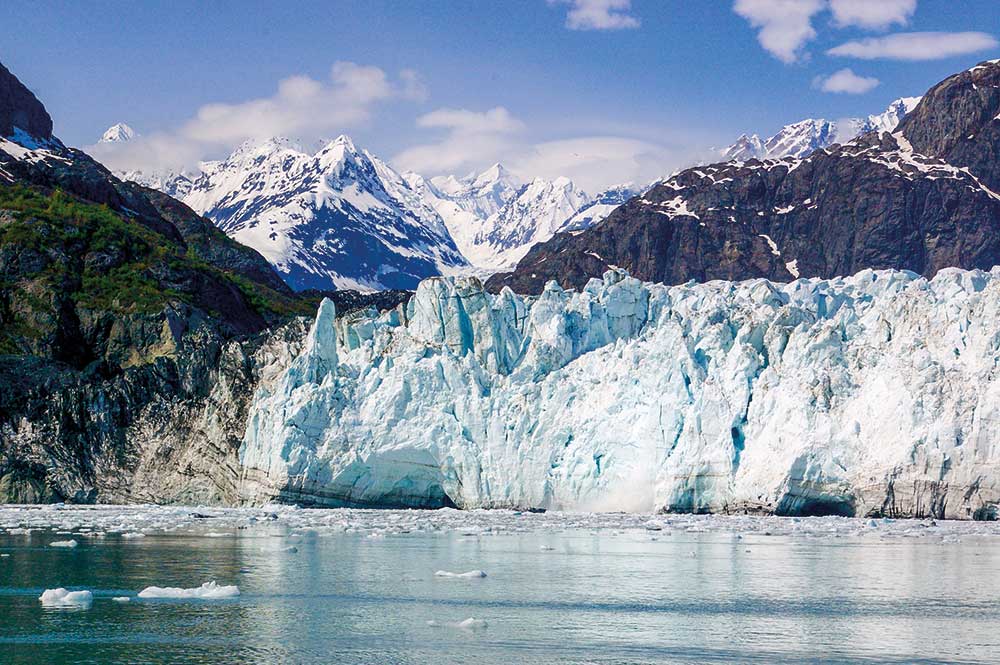
Famed conservationist, John Muir, followed in the late 1800s, and the bay-covering glacier had already receded nearly 50 miles since Vancouver’s first visit. Muir was captivated by the epic mountains, glaciers, blue-green water, and hardy native people—and his name and legacy remain a part of the park at Muir Glacier and Muir Inlet. According to Scheffel and Werner’s Natural Wonders of the World, as recently as 1980 the Muir Glacier was a tidewater glacier with a 200-foot wall of ice calving icebergs into the sea. It has since continued its retreat and no longer extends to the shore, and the resulting bay is now called Muir Inlet. After his extended time in Glacier Bay, Muir summed it up perfectly: “The very thought of this Alaska garden is a joyful exhilaration. … Out of all the cold darkness and glacial crushing and grinding comes this warm, abounding beauty and life…”
Shortly after Muir’s sojourn, Captain Lester S. Beardslee charted the ice-free waters of the region and gave it the name we know of today: Glacier Bay. It was evident then that this was a special place worth preserving and researching, and in 1916, ecologist William S. Cooper from the University of Minnesota made his first trip into the bay to study plant succession. He would return several more times, and eventually recommend National Monument status for Glacier Bay. Following that call to action, President Calvin Coolidge did just that, establishing Glacier Bay National Monument on February 26, 1925. (Source, National Parks Service)
Traveling through Glacier Bay today, visitors are well aware that they are passing shorelines and weaving among islands that were completely covered by ice just over 200 years ago. Glaciers in the park still number more than 1,000 and cover 27 percent of the total area, according to the National Park Service. Of these, however, only seven are tidewater glaciers at the water’s edge, with the vast majority residing at high altitudes above 8,000 feet.
No matter how pristine and wondrous it is, though, you
can’t help but see some of the challenges that face the future of the park.
CHALLENGES & CONSERVATION MEASURES
Cruise ships, private boats, campers, commercial fishing, and climate change, among numerous other variables—all represent challenges to this fragile environment and the wildlife that call it home. Throughout the years, it has been a balancing act to put restrictions in place that allow humans access without creating too negative an impact.
When talking to a ranger at park headquarters in Bartlett Cove about the dynamism of Glacier Bay and its utterly pristine nature, I got a very poignant answer: “We have to balance what makes the park so special with allowing people to experience it. A limited number of visitors and researchers are here at any given time—whether they arrive on a cruise ship or a pleasure craft—and what they are witnessnessing is life starting from scratch and unfolding in front of their eyes. Glaciers here are retreating while others are advancing. That’s unique. But it’s fragile.”
 Unlike many wild places in the contiguous 48 states that are essentially islands of wilderness surrounded by development, Glacier Bay has a solitude and wildness that is nearly devoid of human interference—and flora and fauna flourish accordingly. With that in mind, laws have been enacted and restrictions put in place to help curb human encroachment.
Unlike many wild places in the contiguous 48 states that are essentially islands of wilderness surrounded by development, Glacier Bay has a solitude and wildness that is nearly devoid of human interference—and flora and fauna flourish accordingly. With that in mind, laws have been enacted and restrictions put in place to help curb human encroachment.
Currently, only two cruise ships are allowed in the park per day. They are there for no more than eight hours and don’t land passengers ashore. In the late 1990s, the State of Alaska passed laws aimed to restrict commercial and sustenance fishing inside the park. Camping is allowed in designated areas only and permits are required. For everyone who touches the park, a strict “Leave No Trace” policy is encouraged. And, the amount of cruising boats permitted to be in the bay during the high season is restricted to 25 (see sidebar for more info).
The stewards of Glacier Bay National Park & Preserve are committed to a high level of environmental management, both in the context of the values for which the park and preserve were established and in the broader context of national and international environmental responsibilities. Rangers are there to provide vital information to visitors, but also to ensure compliance with all applicable federal, state, and local laws, regulations, requirements, policies, and Executive Orders addressing the protection of the environment.
They incorporate pollution prevention, waste reduction, best environmental management practices and environmentally preferable purchasing in all park management activities, and strive for continual improvement in each of these areas. Park managers seemed to be realistic in these goals when I chatted with them, and recognized that this mission is a moving target. It is a mission that requires continual effort and commitment of energy and resources.
Key to the balance mentioned by the ranger is ensuring careful human access and visibility to build connections, appreciation, and conservation investment in Glacier Bay—even to teach environmental principles that could be applied elsewhere. A benefit of the park’s allowance of short-term cruise ship visits is the increased number of people who have the opportunity to experience this magical place. The National Park Service shares that the number of people who got to see Glacier Bay from cruise ships in 2016 (485,415) was ten-times greater than those who visited the park in all other fashions, land or sea, combined (47,232).
A CRUISER’S PLAYGROUND
While Yahtzee heeled gently with the wind, I stood on the edge of the cockpit and took a long, awe-inspiring look at my surroundings—mountains, trees, islands, and water converging in one spectacular park.
The breeze played with my hood as I spun 360-degrees, basking in the grand, pristine, and hallowed world of Glacier Bay National Park & Preserve. It had been a week since we sailed into the bay from Icy Strait and with each passing moment, I’d come to realize that I was experiencing this environment in a deeper, more ethereal way than I ever have. Our whole family was.
For the crew of Yahtzee, our week in Glacier Bay unfolded from one anchorage to the next during a magical spell of warm weather, sunny skies, light breezes, and just enough gentle rain to make wildflowers pop in bloom.
Working north through the bay from the park headquarters at Bartlett Cove, snowy peaks grew taller and closer to the water. Three-thousand to fifteen-thousand foot pinnacles rose from the sea and we cruised amongst it all with just a few other boats. At our first anchorage in Berg Bay, we were captivated by humpback whales swimming right through the cove, mere feet from the boat. From then on, we spotted whales everyday, sometimes multiple times a day.
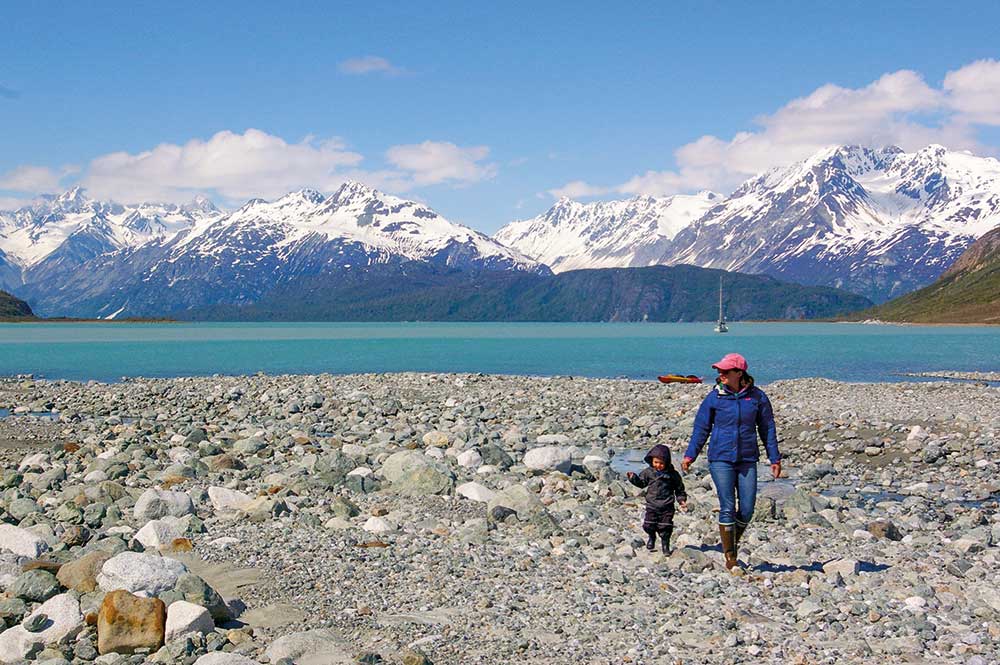
In our next stop at Blue Mouse Cove, bears roamed the shorelines and a couple curious wolves contemplated us from a distance. We watched eagles snatch a meal from the water and black oystercatchers squawked at us while we strolled the beach. The following day, while continuing our path northward, we spotted mountain goats munching on grassy cliffs and porpoises diving in Yahtzee’s bow wake in perfect rhythm.
While anchored at Reid Inlet we hiked over glacial till, picked up chunks of ice and climbed to a rocky promontory overlooking places that were once filled with ice and snow. At nearby Russell Island we sailed our little Quartermaster 8 in the shadows of tall mountains and hanging glaciers, and basked in the late night glow of the setting sun. Every anchorage seemed to top the last, and each day was more insatiable and fulfilling than the one before it.
MORE THAN JUST A PRETTY PLACE
Signs of human encroachment, including litter in the water and on beaches, or campsites and fire rings, were nonexistent during our time in Glacier Bay—which is a first in all the places we’ve cruised on Yahtzee. A success in the Park stewards’ mission for balance—structural limitations to traffic contribute to this untarnished natural ecosystem, but so does the empowerment for all users to take great care of it.
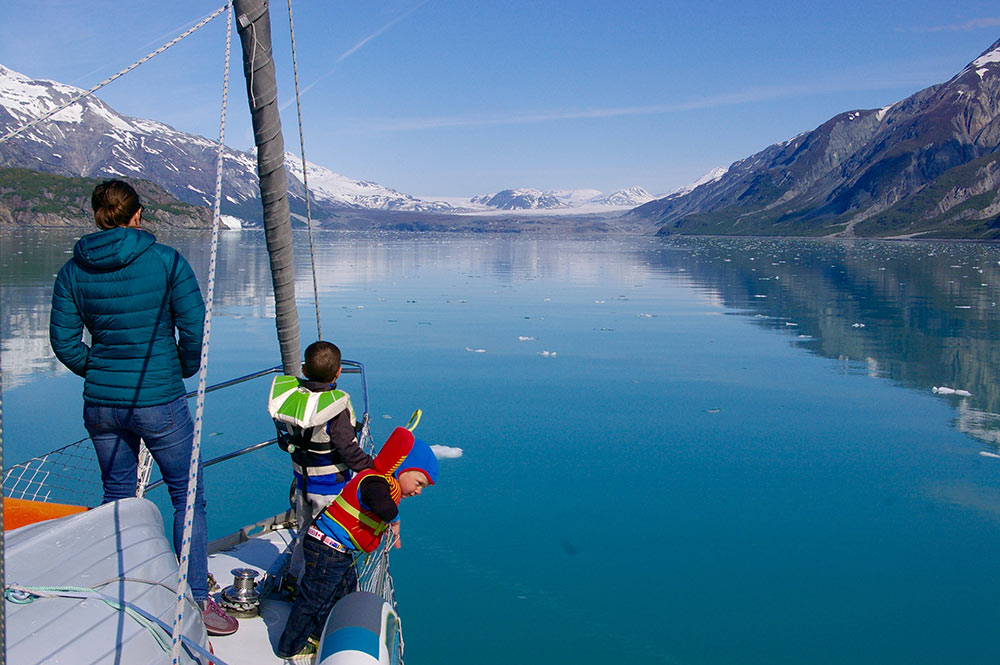 The raw earth being cut by active glaciers right before our eyes allowed a glimpse at a changing world. Massive Margerie Glacier’s tumbling finale as giant chunks calved into the sea was a sight to behold. All of it made us wonder what this place will look like if our sons, Porter and Magnus, sail back here on their own one day.
The raw earth being cut by active glaciers right before our eyes allowed a glimpse at a changing world. Massive Margerie Glacier’s tumbling finale as giant chunks calved into the sea was a sight to behold. All of it made us wonder what this place will look like if our sons, Porter and Magnus, sail back here on their own one day.
Every visitor’s experience in the park is different, and depends heavily on mode of travel, length of stay, and the weather. Yet in spite of those variables, it’s easy to see why Glacier Bay captures the hearts and imaginations of those fortunate enough to have traveled or lived here; nearly all leave feeling changed.
A place that exudes this dynamic beauty, inspires such unadulterated wonder, and displays perpetual change deserves to be taken care of for generations to come—and we were happy to see the National Park Service, Biosphere Preserve project, and individual visitors are all doing just that.
HOW DO PARK PERMITS WORK?
The National Park System works to protect the Glacier Bay National Park by restricting boating, overnight camping, number of cruise ships, and commercial fishing—among many other things. It can be a source of frustration for some sailors who find it difficult to cruise on a schedule, but it’s important for visiting cruisers to work within the permit system to gain entry to the park and to help protect this fragile ecosystem.
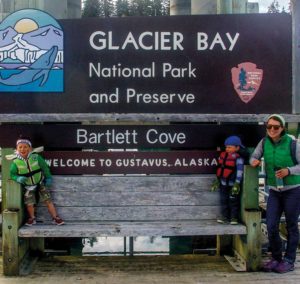 Only 25 private vessels are allowed permitted access each day between June 1 and August 31. Of those 25 permits, 13 are designated “Advanced Notice Permits” (60 days prior to entry) and 12 are “Short Notice Permits” (48 hours in advance of requested entry date). If you’re planning a visit from June 20 through July 20—the busiest time in the park—it is strongly advised that you apply in advance. Both permit types allow seven consecutive days, counting the first day of your permit (i.e. 7 day and 6 night maximum). If you’re looking to stay past the initial 7 days and 6 nights, boaters can actually hold up to two permits at any given time. This will give you a maximum of 14 days out of each 21 day period.
Only 25 private vessels are allowed permitted access each day between June 1 and August 31. Of those 25 permits, 13 are designated “Advanced Notice Permits” (60 days prior to entry) and 12 are “Short Notice Permits” (48 hours in advance of requested entry date). If you’re planning a visit from June 20 through July 20—the busiest time in the park—it is strongly advised that you apply in advance. Both permit types allow seven consecutive days, counting the first day of your permit (i.e. 7 day and 6 night maximum). If you’re looking to stay past the initial 7 days and 6 nights, boaters can actually hold up to two permits at any given time. This will give you a maximum of 14 days out of each 21 day period.
An active permit is required to transit between the entrance to the bay and Bartlett Cove, and all boaters are required to make a radio call to “KWM20 Bartlett Cove” on VHF channel 12 or 16 immediately upon entering the bay. You must then proceed directly to the Visitor Information Station in Bartlett Cove for a required orientation prior to continuing into Glacier Bay. Note: Pets are not allowed on shore anywhere in Glacier Bay National Park, except on a leash in the Bartlett Cove developed area.
You can apply for permits by email, phone, fax, VHF radio, or USPS mail, but applications sent by email are preferred. Visit https://www.nps.gov/glba/planyourvisit/boat.htm for more information
Andy Cross
Andy Cross is the editor of 48° North. After years cruising the Pacific Northwest and Alaska with his family aboard their Grand Soleil 39, Yahtzee, they sailed south and are currently in the Caribbean Sea. You can follow their adventures at SailingYahtzee.com.



